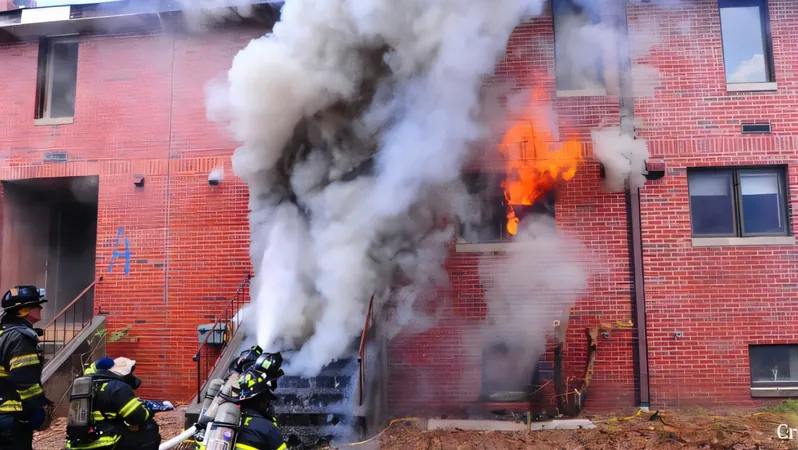
Revolutionary AI System Transforms Fire Detection with Standard Security Cameras
2025-09-10
Author: Wei
Every year, nearly 3,700 Americans lose their lives to fires, with property damages reaching a staggering $23 billion. A significant number of these tragedies could be averted if fire detection technology were more reliable. Fortunately, the NYU Fire Research Group at NYU Tandon School of Engineering has made a breakthrough that promises to change the landscape of fire safety.
This innovative artificial intelligence system employs ordinary security cameras, which are already prevalent in many buildings, to detect fires and smoke in real-time—an impressive feat that could save lives. Published in the IEEE Internet of Things, the research showcases an AI capable of analyzing video footage and identifying flames in just 0.016 seconds per frame, much faster than the blink of an eye. This rapid detection could provide occupants with invaluable extra minutes to evacuate.
Speed and Coverage: A Game Changer
Lead researcher Prabodh Panindre emphasizes the advantages of this AI system, stating that its speed and expansive coverage far outstrip traditional smoke detectors. "A single camera can monitor a much larger area than conventional systems, and we can identify fires before they produce enough smoke to trigger typical alarms," he explained.
The Urgent Need for Enhanced Technology
The necessity for improved fire detection solutions is alarming. Statistics reveal that 11% of residential fire fatalities occur in homes without functioning smoke detectors. As modern building materials promote rapid fire spread and shorter structural collapse times, the stakes have never been higher.
Cutting-Edge AI Algorithms at Work
The NYU Tandon team developed a sophisticated ensemble approach, integrating multiple top-tier AI algorithms. This method significantly cuts down false alarms, crucial for emergency scenarios. By training their models on a diverse dataset encompassing various types of fires recognized by the National Fire Protection Association, they achieved impressive detection accuracy, with the leading model combination hitting 80.6%.
Dynamic Analysis for Accurate Detection
To further enhance reliability, the system employs temporal analysis to differentiate genuine fires from stationary objects that may mimic flames. As Professor Sunil Kumar explained, "Real fires are dynamic; they grow and change shape. Our system effectively tracks these changes, achieving a remarkable 92.6% accuracy in eliminating false detections."
Cloud-Based Architecture for Maximum Efficiency
Operating within a cloud-based Internet of Things framework, the AI analyzes video feeds from multiple standard cameras, generating real-time alerts and video clips directly to emergency services. This means the technology can leverage existing CCTV infrastructure, making it cost-effective for widespread implementation.
Aerial Applications for Wildfire Detection
In addition to building safety, this technology can be adapted for drones, enabling them to detect wildfires in remote areas. Early detection could provide crucial hours for containment efforts, enhancing resource deployment and prioritizing evacuations to mitigate ecological damage.
Revolutionizing Firefighting Tools
The detection system can also be integrated into firefighting equipment, such as helmet cameras, thermal imagers, and drones, offering firefighters real-time data. Capt. John Ceriello of the New York City Fire Department notes, "This technology can help confirm fire locations and identify trapped occupants, significantly improving our emergency response effectiveness."


 Brasil (PT)
Brasil (PT)
 Canada (EN)
Canada (EN)
 Chile (ES)
Chile (ES)
 Česko (CS)
Česko (CS)
 대한민국 (KO)
대한민국 (KO)
 España (ES)
España (ES)
 France (FR)
France (FR)
 Hong Kong (EN)
Hong Kong (EN)
 Italia (IT)
Italia (IT)
 日本 (JA)
日本 (JA)
 Magyarország (HU)
Magyarország (HU)
 Norge (NO)
Norge (NO)
 Polska (PL)
Polska (PL)
 Schweiz (DE)
Schweiz (DE)
 Singapore (EN)
Singapore (EN)
 Sverige (SV)
Sverige (SV)
 Suomi (FI)
Suomi (FI)
 Türkiye (TR)
Türkiye (TR)
 الإمارات العربية المتحدة (AR)
الإمارات العربية المتحدة (AR)